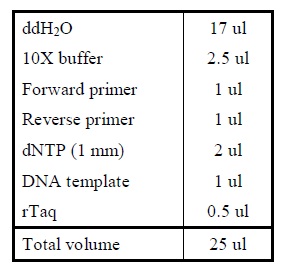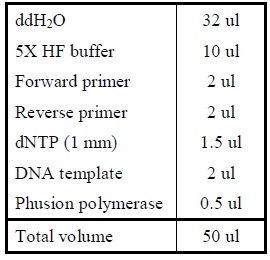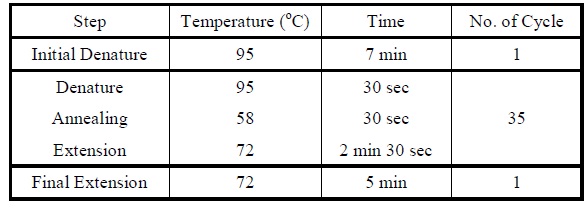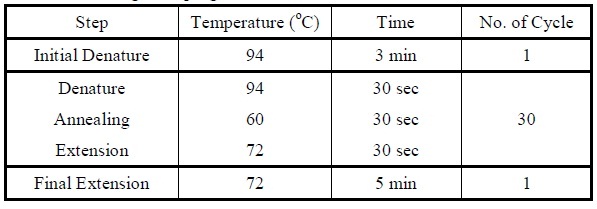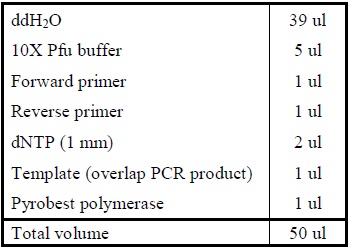Team:HKU-Hong Kong/Lab Protocol
From 2011.igem.org
| Line 162: | Line 162: | ||
1. First, two PCR reactions are set for amplifying the two genes, tetR and HNS, separately. | 1. First, two PCR reactions are set for amplifying the two genes, tetR and HNS, separately. | ||
| + | |||
| + | 2. Add the following reagents into a PCR tube (in order) and mix well.</LI> | ||
| + | <div ALIGN=CENTER> | ||
| + | {| style="width:254px;background:#99EE63;text-align:center;font-family: georgia, helvetica, arial, sans-serif;color:#000000;margin- top:5px;padding: 2px;" cellspacing="5"; | ||
| + | |[[Image:Overlap_pcr.jpg|450px]] | ||
| + | |} | ||
| + | </div> | ||
| + | |} | ||
| + | {| style="width:900px;background:#000000;text-align:justify;font-family: georgia, helvetica, arial, sans-serif;color:#ffffff;margin-top:25px;" cellspacing="20" | ||
| + | |style="width:900px;"| | ||
| + | |||
| + | 3. Set the following PCR program. | ||
| + | <div ALIGN=CENTER> | ||
| + | {| style="width:254px;background:#99EE63;text-align:center;font-family: georgia, helvetica, arial, sans-serif;color:#000000;margin- top:5px;padding: 2px;" cellspacing="5"; | ||
| + | |[[Image:Overlap_pcr_program.jpg|450px]] | ||
| + | |} | ||
| + | </div> | ||
| + | |} | ||
| + | {| style="width:900px;background:#000000;text-align:justify;font-family: georgia, helvetica, arial, sans-serif;color:#ffffff;margin-top:25px;" cellspacing="20" | ||
| + | |style="width:900px;"| | ||
| + | |||
| + | 4. Set up another PCR reaction using a primer with a linker to link the two genes. | ||
| + | |||
| + | 5. Add the following reagents into a PCR tube (in order) and mix well. | ||
| + | <div ALIGN=CENTER> | ||
| + | {| style="width:254px;background:#99EE63;text-align:center;font-family: georgia, helvetica, arial, sans-serif;color:#000000;margin- top:5px;padding: 2px;" cellspacing="5"; | ||
| + | |[[Image:Overlap_pcr_2.jpg|450px]] | ||
| + | |} | ||
| + | </div> | ||
| + | |} | ||
| + | {| style="width:900px;background:#000000;text-align:justify;font-family: georgia, helvetica, arial, sans-serif;color:#ffffff;margin-top:25px;" cellspacing="20" | ||
| + | |style="width:900px;"| | ||
| + | |||
| + | 6. Set the following PCR program. | ||
| + | <div ALIGN=CENTER> | ||
| + | {| style="width:254px;background:#99EE63;text-align:center;font-family: georgia, helvetica, arial, sans-serif;color:#000000;margin- top:5px;padding: 2px;" cellspacing="5"; | ||
| + | |[[Image:Overlap_pcr_program_2.jpg|450px]] | ||
| + | |} | ||
| + | </div> | ||
| + | |} | ||
| + | {| style="width:900px;background:#000000;text-align:justify;font-family: georgia, helvetica, arial, sans-serif;color:#ffffff;margin-top:25px;" cellspacing="20" | ||
| + | |style="width:900px;"| | ||
| + | |||
| + | 7. Set up another PCR reaction to further amplify the fused product. | ||
| + | |||
| + | 8. Add the following reagents into a PCR tube (in order) and mix well. | ||
| + | <div ALIGN=CENTER> | ||
| + | {| style="width:254px;background:#99EE63;text-align:center;font-family: georgia, helvetica, arial, sans-serif;color:#000000;margin- top:5px;padding: 2px;" cellspacing="5"; | ||
| + | |[[Image:Overlap_pcr_3.jpg|450px]] | ||
| + | |} | ||
| + | </div> | ||
| + | |} | ||
| + | {| style="width:900px;background:#000000;text-align:justify;font-family: georgia, helvetica, arial, sans-serif;color:#ffffff;margin-top:25px;" cellspacing="20" | ||
| + | |style="width:900px;"| | ||
| + | |||
| + | 9. Set the following PCR program. | ||
<div ALIGN=CENTER> | <div ALIGN=CENTER> | ||
{| style="width:254px;background:#99EE63;text-align:center;font-family: georgia, helvetica, arial, sans-serif;color:#000000;margin- top:5px;padding: 2px;" cellspacing="5"; | {| style="width:254px;background:#99EE63;text-align:center;font-family: georgia, helvetica, arial, sans-serif;color:#000000;margin- top:5px;padding: 2px;" cellspacing="5"; | ||
| - | |[[Image: | + | |[[Image:Overlap_pcr_program_3.jpg|450px]] |
|} | |} | ||
</div> | </div> | ||
| Line 171: | Line 227: | ||
|style="width:900px;"| | |style="width:900px;"| | ||
| - | |||
| - | |||
| - | |||
| - | |||
| - | |||
| - | |||
| - | |||
| - | |||
| - | |||
| - | |||
|- | |- | ||
Revision as of 02:16, 5 October 2011
| Lab Protocol |
| A. DNA WORK |
| Agarose Gel Electrophoresis |
|
| DNA Extraction from Agarose Gel |
|
| DNA Digestion |
|
1. Add the following reagents, with the enzymes added at the last, into a tube |
|
2. All steps should be carried out on ice. 3. Mix well after addition of all the reagent. 4. Incubate the mixture at 37oC for several hours. |
| Miniprep(Adopt from Qiagen) |
|
| Polymerase Chain Reaction |
|
Colony PCR 1. Add the following reagents into a PCR tube (in order) and mix well. |
|
2. Set the following PCR program. |
|
1. Add the following reagents into a PCR tube (in order) and mix well. |
|
2. Set the following PCR program. |
|
Overlap PCR 1. First, two PCR reactions are set for amplifying the two genes, tetR and HNS, separately. 2. Add the following reagents into a PCR tube (in order) and mix well.</LI> |
|
3. Set the following PCR program. |
|
4. Set up another PCR reaction using a primer with a linker to link the two genes. 5. Add the following reagents into a PCR tube (in order) and mix well. |
|
6. Set the following PCR program. |
|
7. Set up another PCR reaction to further amplify the fused product. 8. Add the following reagents into a PCR tube (in order) and mix well. |
|
9. Set the following PCR program. |
|
|
| DNA ligation |
|
| Sequencing |
|
| B. BACTERIAL WORK |
| Overnight culture |
|
| Preparation of competent cell |
|
| Spread plate |
|
| Streak plate |
|
| Transformation |
|
| C. Preparation of materials |
| Preparation of ampicillin |
|
| Preparation of LB agar plate |
|
| Preparation of LB broth |
|
| Preparation of 1X TAE buffer |
|
| D. Protein Work |
| Gel Shift Assays (Adopt from Promega) |
|
 "
"




